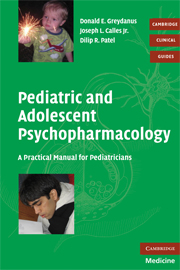Book contents
- Frontmatter
- Contents
- Contributors
- Foreword by Christopher K. Varley
- Foreword by Renée R. Jenkins
- Preface
- Acknowledgement
- 1 Principles of psychological management
- 2 The basics of pharmacology and neurotransmission
- 3 Basics of prescribing psychopharmacologic agents
- 4 Anxiety disorders
- 5 Attention deficit/hyperactivity disorder
- 6 Child and adolescent depression
- 7 Disruptive behavior and aggressive disorders
- 8 Schizophrenia in childhood and adolescence
- 9 Autism spectrum disorders
- 10 Psychotropic management of children and adolescents with cognitive–adaptive disabilities
- 11 Sleep disorders in children and adolescents
- 12 Tic disorders in children and adolescents
- 13 Substance abuse disorders
- Subject index
- References
7 - Disruptive behavior and aggressive disorders
Published online by Cambridge University Press: 18 December 2009
- Frontmatter
- Contents
- Contributors
- Foreword by Christopher K. Varley
- Foreword by Renée R. Jenkins
- Preface
- Acknowledgement
- 1 Principles of psychological management
- 2 The basics of pharmacology and neurotransmission
- 3 Basics of prescribing psychopharmacologic agents
- 4 Anxiety disorders
- 5 Attention deficit/hyperactivity disorder
- 6 Child and adolescent depression
- 7 Disruptive behavior and aggressive disorders
- 8 Schizophrenia in childhood and adolescence
- 9 Autism spectrum disorders
- 10 Psychotropic management of children and adolescents with cognitive–adaptive disabilities
- 11 Sleep disorders in children and adolescents
- 12 Tic disorders in children and adolescents
- 13 Substance abuse disorders
- Subject index
- References
Summary
Children and adolescents with behavioral disturbances commonly come to the attention of primary care physicians. Although disruptive behaviors can be associated with any number of psychiatric disorders, this chapter will focus on three diagnoses wherein behavioral symptoms are key diagnostic criteria: oppositional defiant disorder (ODD), conduct disorder (CD), and intermittent explosive disorder (IED). A fourth diagnosis, attention-deficit/hyperactivity disorder (ADHD), is usually included in the disruptive behavior disorder (DBD) category, but will not be included in this chapter (see Chapter 4 for details about the treatment of ADHD).
Definition
The disorders covered in this chapter are considered disruptive, in that individuals diagnosed with them evidence behaviors that have a negative effect on their immediate environment and elicit negative responses from others. A common element of the negative behavior is aggression, which can be verbal or physical. Verbal aggression includes loud, profane, or threatening speech that intimidates others. Physical aggression includes damage to property or person, the latter also known as violence. Violent behavior exists in two basic forms: proactive aggression, which is premeditated and fairly dispassionate; reactive aggression is impulsive and affectively driven. The distinction between proactive and reactive aggression is an important one, since it is the reactive type that tends to respond to pharmacotherapy.
The disruptive aspect of ODD comes from the conflict that the individual has with rules and authority figures. Legal problems associated with ODD are relatively minor, e.g. truancy and running away.
- Type
- Chapter
- Information
- Pediatric and Adolescent PsychopharmacologyA Practical Manual for Pediatricians, pp. 117 - 132Publisher: Cambridge University PressPrint publication year: 2008
References
- 1
- Cited by



